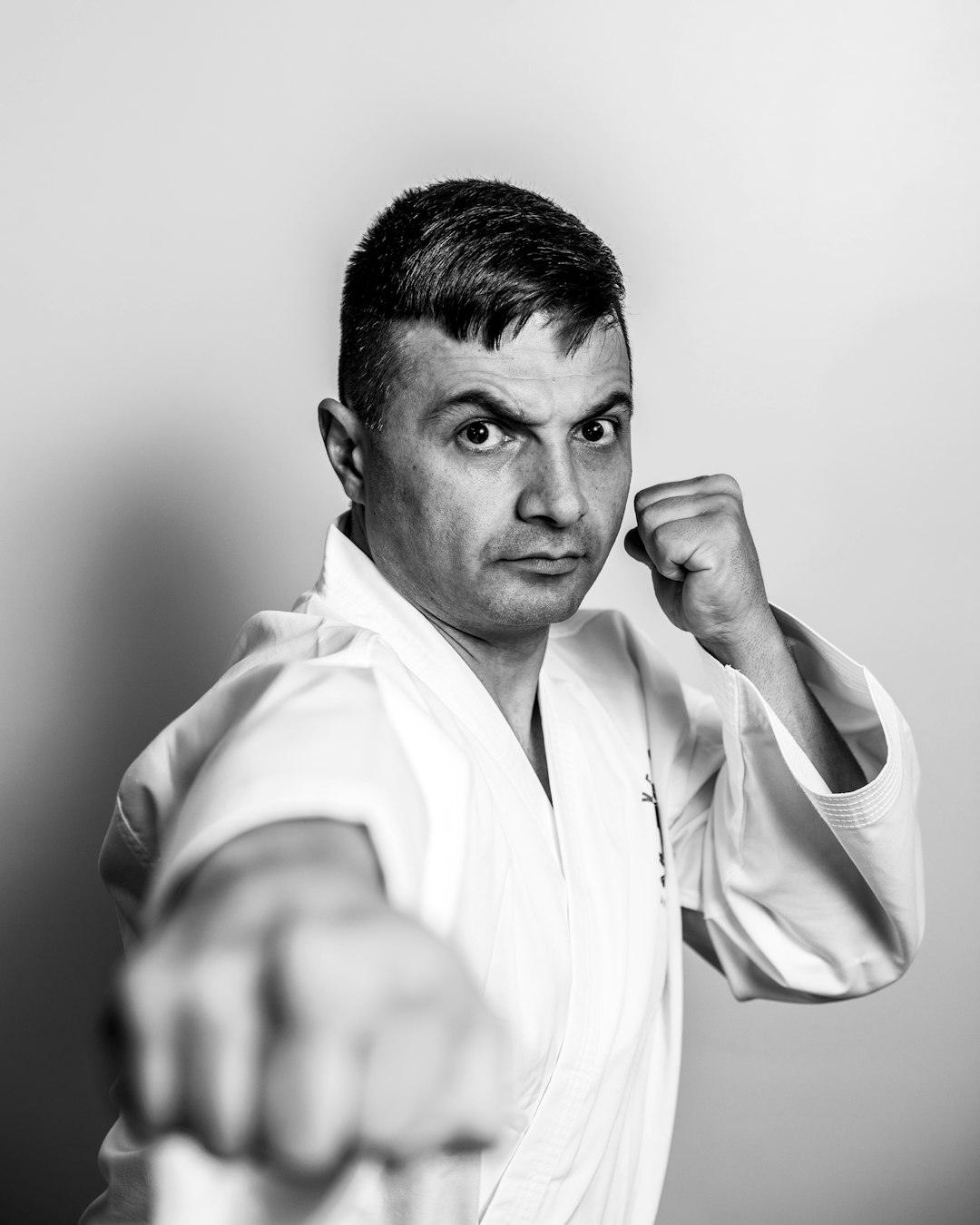When practicing karate, it's crucial to wear appropriate attire like a karate gi, which is both comfortable and respectful of the sport's traditions. The ideal gi should be made of heavyweight cotton or hemp, offering a balance between flexibility and durability for training. It includes a jacket called 'ude oshi gaeshi' and straight-legged pants called 'rei gi,' with string or snap button closures. The traditional colors white or black symbolize purity and humility, respectively. A belt, or 'obi,' is also essential, serving as an indicator of rank within the martial art community. For those engaging in serious practice or competitions, selecting high-quality karate equipment that is breathable and moisture-wicking is important, ensuring a snug fit without restricting movement. Additionally, protective gear like gum shields are necessary for sparring to prevent dental injuries, while focus pads and kick shields are key for honing striking techniques safely. Maintaining your karate gi by washing it in cold water on a gentle cycle with mild detergent, avoiding bleach and high temperatures, is essential for its longevity and your comfort during practice. Proper care of your karate uniform, along with the right equipment, is fundamental to an effective training regimen and overall safety in the dojo.
Embark on a journey through the discipline of karate, where the uniform, a pivotal element in practitioners’ training, holds significance beyond mere attire. This article delves into the essentials of karate equipment needed, shedding light on the traditional and functional aspects of the karate gi. From the fibers that compose it to the styles that reflect personal choice, we explore what constitutes a genuine karate uniform. Whether you’re an aspiring martial artist or an enthusiast seeking knowledge, this guide will assist in selecting your Gi for peak performance and guide you on accessorizing with additional equipment for enhanced training experiences. We also provide valuable care and maintenance tips to ensure your gear remains in optimal condition. Join us as we unravel the intricacies of the karate uniform, a garment steeped in tradition and integral to the martial art’s practice.
- Understanding the Essentials: The Composition of a Karate Uniform
- The Karate Gi: A Closer Look at Materials and Styles
- Selecting Your Gi: Factors to Consider for Optimal Performance
- Accessorizing for Success: Additional Karate Equipment to Enhance Training
- Maintaining Your Gear: Care and Maintenance Tips for Your Karate Uniform
Understanding the Essentials: The Composition of a Karate Uniform

When practicing the disciplined art of karate, donning the appropriate attire is key to ensuring both comfort and respect for the tradition. A karate uniform, or ‘gi,’ is a fundamental piece of karate equipment needed for any practitioner. The gi typically consists of a jacket and pants, both made from a heavyweight cotton fabric that allows for ease of movement while withstanding the rigors of training. Does the material of the karate uniform affect performance? Absolutely; traditional cotton is preferred for its durability and breathability, providing a balance between structure and flexibility. The jacket, known as ‘ude oshi gaeshi,’ features long sleeves that are often rolled up to the elbows during practice, while the pants, called ‘rei gi,’ are straight-legged with a closure system of either strings tied at the waist or snap buttons. Are these elements common across all karate uniforms? While there may be variations in style, the essential composition of a karate gi is consistent worldwide, with each component designed to facilitate proper form and movement during practice and competition. The color of the gi traditionally ranges from white to black, symbolizing purity and humility, respectively. In addition to the jacket and pants, a belt, or ‘obi,’ is worn around the waist, not only as part of the traditional ensemble but also to signify rank within the karate community. Choosing the right karate equipment needed for your practice ensures you are fully prepared to train with respect to tradition and readiness for performance.
The Karate Gi: A Closer Look at Materials and Styles

When practicing the disciplined art of karate, the practitioner’s attire plays a crucial role in their performance and comfort. Among the essential karate equipment needed for any martial artist is the Karate Gi, a traditional garment that serves as both a uniform and a symbol of respect for the martial art. The Gi, which translates to “uniform” or “jacket” in Japanese, is typically made from either cotton or hemp materials, each offering distinct advantages. For instance, cotton Gis are known for their softness and comfort, making them an excellent choice for beginners and seasoned practitioners alike. Hemp Gis, on the other hand, are often praised for their durability and breathability, which can be beneficial during vigorous training sessions.
In terms of styles, there are a few types of Karate Gis to consider. The most common styles include the traditional white Gi, which is worn in virtually all karate dojos around the world, and the competition or judogi, which may come in different colors but is still approved for tournament use by various karate organizations. Each style serves a purpose: the traditional white Gi reflects the purity and simplicity of the martial art, while the judogi’s reinforced areas and thicker fabric offer more protection during sparring matches. Whether you are an enthusiast seeking karate equipment needed for daily practice or a competitor preparing for a tournament, choosing the right Gi is essential for both functionality and respect for the tradition of karate.
Selecting Your Gi: Factors to Consider for Optimal Performance

When selecting your gi for karate practice, it’s crucial to consider several factors that can influence both your comfort and performance. The fabric is one such consideration; does the weave offer a balance between breathability and durability? A gi made of a high-quality, lightweight cotton or a blend that wicks away moisture will ensure you remain cool and dry during intense training sessions. Additionally, the fit of the gi should be tailored to your body without being overly restrictive; it should allow for a full range of motion, enabling you to execute techniques with ease. Opting for a gi that’s too loose may cause it to catch on objects or opponents during practice, while one that’s too tight may limit your mobility. Does the gi meet these requirements? A well-fitted, breathable gi can significantly enhance your training experience and help you perform at your best. It’s also important to consider the color and style of the gi, as different karate disciplines may have specific regulations regarding the appearance of the uniform. Are the colors and design in compliance with your dojo’s or competition’s rules? Ensuring that your gi adheres to these standards will prevent disqualification or unnecessary distraction during sparring or demonstrations. By carefully selecting your karate gi based on these factors, you can ensure that it serves its purpose effectively, allowing you to focus on improving your skills without unnecessary constraints.
Accessorizing for Success: Additional Karate Equipment to Enhance Training

When preparing for a karate training session, having the right equipment is paramount to ensuring both safety and effectiveness. Beyond the essential karate uniform, which provides the necessary freedom of movement while being respectful of tradition, there are several key items that can enhance your practice and support your progress in this discipline. For instance, protective gear such as gum shields are crucial for safeguarding your teeth during sparring sessions. Are gum shields mandatory in all karate styles and settings? Indeed, they are often required, especially during contact-based training or competitions, to prevent dental injuries.
In addition to protective equipment, other accessories can significantly contribute to a more productive training regimen. Karate belts, while not exclusive to training, serve as both a symbol of rank and a tool for maintaining proper posture and grip during exercises. Do the colors of karate belts signify different levels of skill? Yes, they do; each color represents a level of proficiency and dedication within the art of karate. Similarly, focus pads and kick shields are essential for practicing strikes and kicks accurately, allowing practitioners to refine their techniques without fear of causing harm. With these additional items, your karate training can be both safer and more rewarding.
Maintaining Your Gear: Care and Maintenance Tips for Your Karate Uniform

When practicing karate, maintaining your gear, particularly your uniform, is crucial to ensure both your comfort and safety during training. A well-maintained karate uniform not only lasts longer but also performs better, allowing you to focus on perfecting your technique. To begin with, regular washing is a must to keep your gi clean and odor-free after each session. It’s recommended to wash your karate uniform separately in cold water to prevent color fading and damage to the fabric. Are you curious about the best washing machine settings for your karate uniform? Typically, using a gentle cycle with a mild detergent will suffice; however, it’s best to avoid bleach and high-temperature washes, as these can compromise the integrity of the fabric and reduce its lifespan.
Additionally, after washing, it’s essential to air dry your uniform flat or hang it in a well-ventilated area away from direct sunlight to preserve its shape and prevent shrinkage. If you must use a dryer, opt for a low-heat setting and be mindful that frequent exposure to high temperatures can lead to premature wear and tear. Furthermore, regular inspections for any signs of damage or wear are key to catching issues early on. Check the stitching along seams and the condition of the belt loops to ensure they remain secure during practice. Taking these steps will help maintain your karate uniform in top condition, ensuring it supports you throughout your karate journey. Remember, proper care of your karate equipment, including your uniform, contributes significantly to an effective training experience.
In conclusion, a karate uniform, commonly known as a gi, is more than mere attire; it’s a fundamental component of traditional karate practice that signifies respect for the discipline. When selecting your gi, consider factors such as material, style, and fit to ensure optimal performance and comfort during training. As you progress in your martial arts journey, complementing your uniform with appropriate karate equipment will further enhance your experience and technique. Remember to maintain your gi properly to preserve its quality and integrity, ensuring it serves you well over time. Proper care and maintenance are key elements for maintaining the longevity of your karate gear, which is essential for any dedicated practitioner’s arsenal of karate equipment needed.
